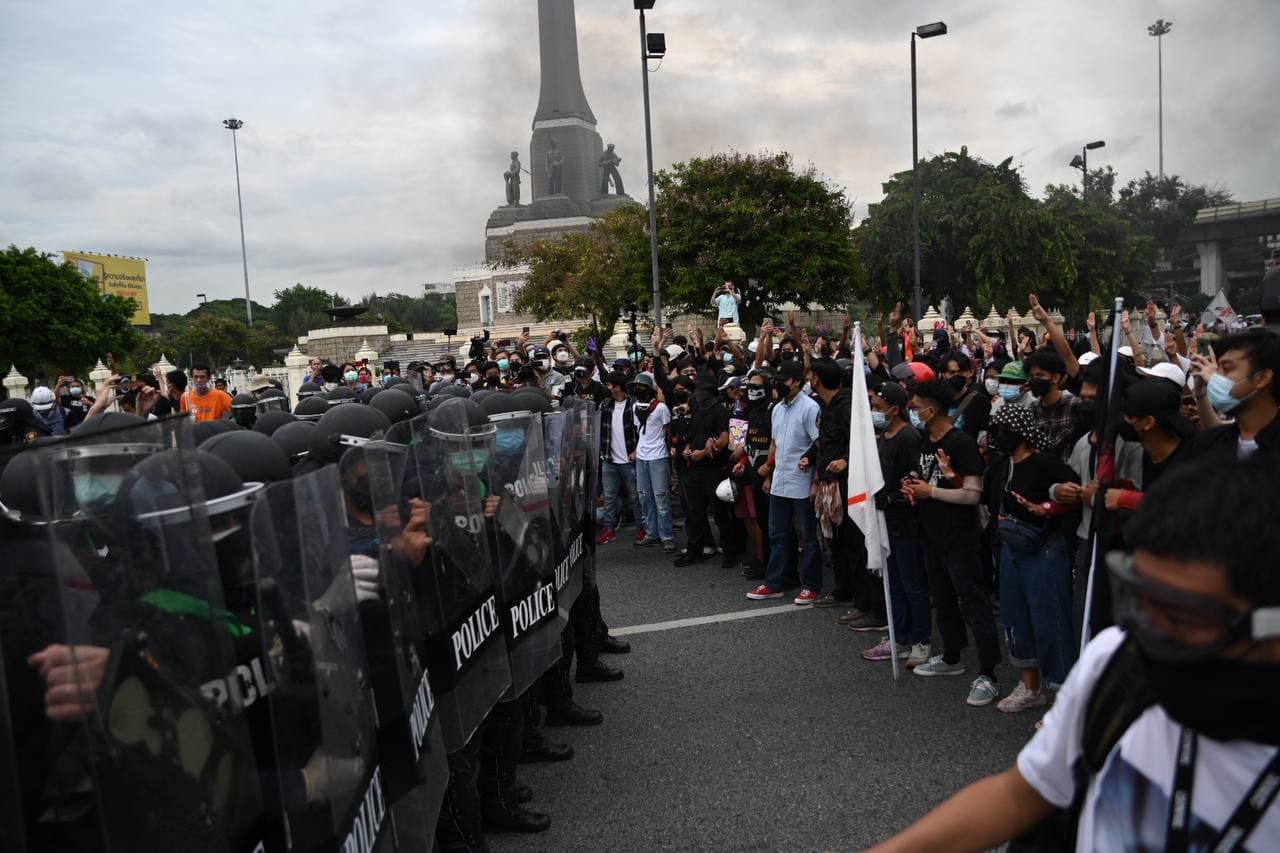Overview of the public assemblies
The organizers, venues, timing, approximate number of participants of public assemblies, number of policing officials
Since the outbreak of public assemblies led by school and university students and members of the public on 18 July 2020 until now. Mob Data Thailand has found at least 1,852 public assemblies have taken place in 77 provinces, despite the Emergency Decree on Public Administration in the State of Emergency has been imposed since 25 March 2020. Other decrees have also been enforced including Regulations, Notification of the Chief Officer of Response During the State of Emergency related to national security and Provincial Governors which ban public gathering or public assembly which may help to spread the disease including the gathering of five persons and upward purportedly for the maintenance of social order and the prevention of the spread of Covid-19.
Nevertheless, a large number of people have come out to demand the government and the authorities to speed up their effort to address the Covid-19 pandemic. They have called out the delayed vaccine rollout and the impacts from national lockdown measures and in areas with high infection rate including the 21.00 – 04.00 curfew. From 7-15 August 2021, various groups have organized protests to demand the removal of General Prayut Chan-ocha as Prime Minister including the Free Youth, Thalu Fah, and Car Mob groups, altogether 35 times at the Democracy Monument, the Ratchaprasong Intersection, the Victory Monument and the Samliam Din Daeng Intersection. The Car Mobs alone have been organized at least 35 times in 28 provinces. Nevertheless, the organizers in Phatthalung and Suratthani had to call off the activities before time due to their concern about safety of the organizers and participants.

Public assembly on 3 August 2021 at Pathumwan Intersection, Bangkok. Photo by Mob Data Thailand
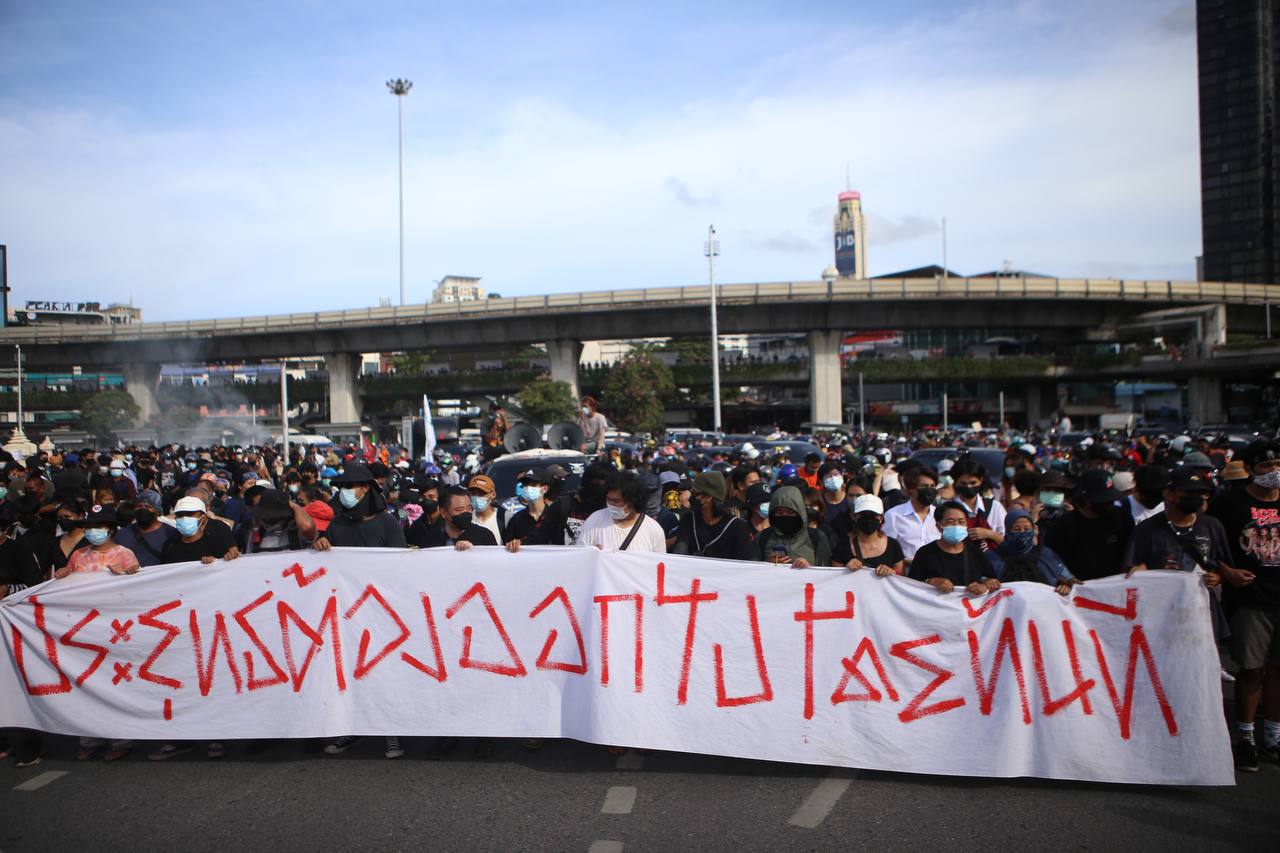
Public assembly on 13 August 2021 from the Victory Monument to 1st Infantry Regement King's Own Bodyguard, Bangkok. Photo by Mob Data Thailand
How force has been used by officials to stop public assemblies, the number and examples of injuries and persons held in custody including children and youth, the press, monitors (if any)
Even though the General Comment no. 37 issued by virtue of Article 21 of the International Covenant on Civil and Political Rights (ICCPR) clearly stipulates that suppression of a public assembly may only be carried out in exceptional circumstances including when such public assemblies are no longer peaceful or if there is clear evidence of an imminent threat of serious violence that cannot be reasonably addressed by more proportionate measures. And even when such conditions are met and the officials may restrict such public assemblies, there are conditions and guidelines with which the officials have to comply as provided by law. Compliance with international human rights principles and standards has to be met as well.
Nevertheless, Amnesty International Thailand has found that all of the public assemblies from 7-15 August 2021 have been dispersed with the use of force by the authorities. In several cases, the crowd control forces and equipment for dispersing public assemblies have been deployed even before the public assemblies began. In some cases, the officials would announce that the action of the participants was in violation of the law, after which they would immediately use tear gas and fire rubber bullets to disperse the crowd. In other cases, the officials would tell the participants to not cross the line where the officials are deployed. Once the participants started to find way to press ahead with their demonstrations, the officials would instantly disperse the public assemblies, for example.

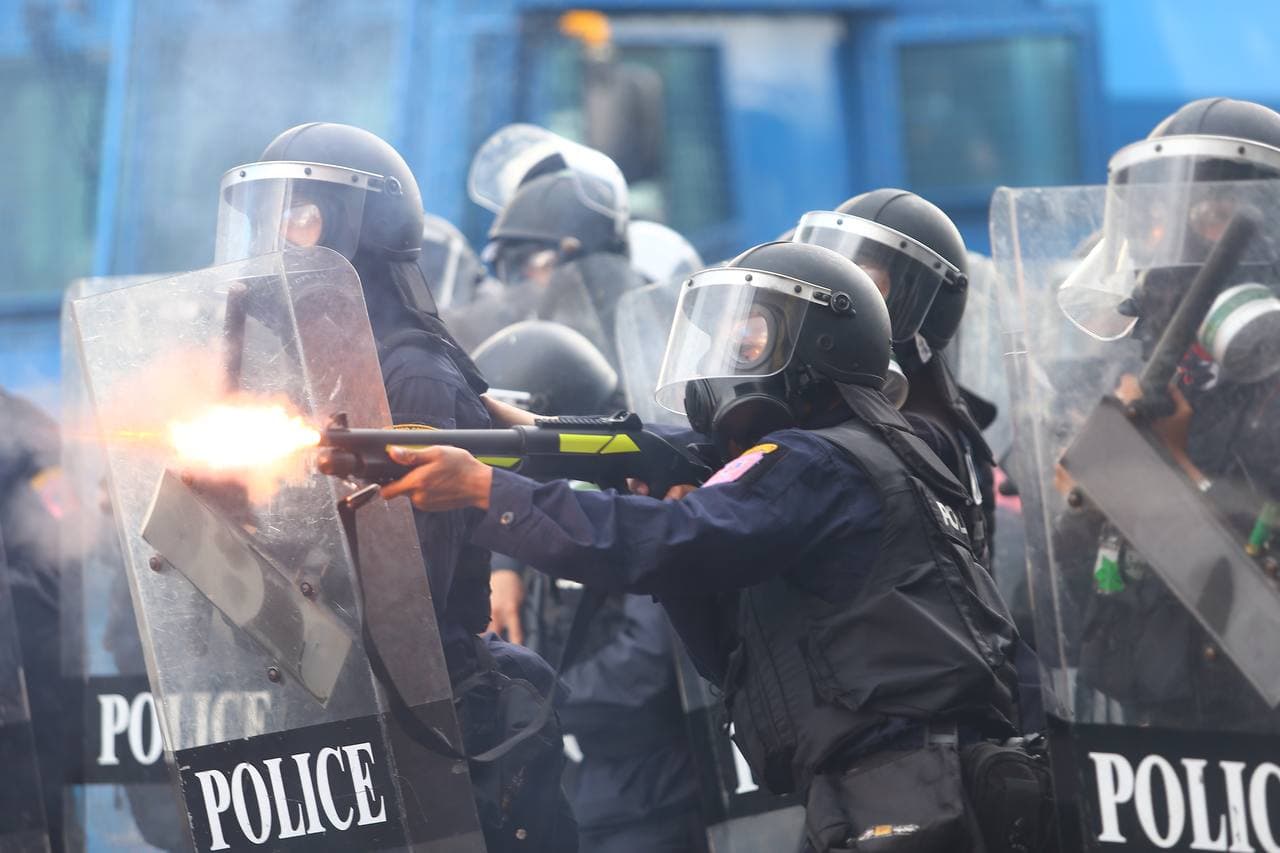
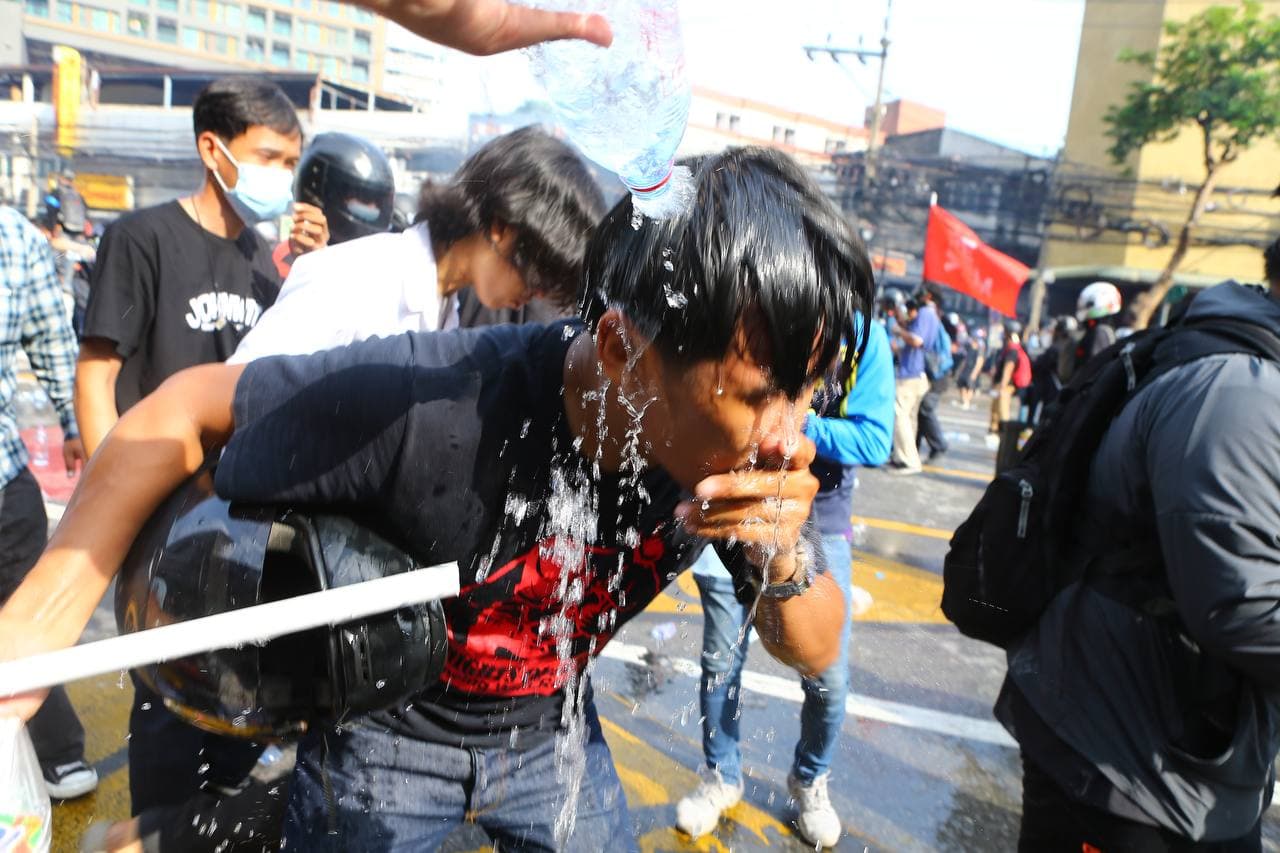
The dispersal of the public assembly on 7 August 2021 at the Victory Monument, Bangkok. Photo by Mob Data Thailand.
In addition, AIT has also found that attempts have been made to use force to apprehend some participants using it as a tactic leading to the suppression of the public assemblies. The use of force during the apprehension has, however, been made excessively since it involved the firing of a barrage of rubber bullets and tear gas, kicking down motorcycles driven by the participants, etc., leading to a number of injuries and persons held in custody. According to Mob Data Thailand and the Thai Lawyers for Human Rights (TLHR), from 7-15 August 2021, 98 persons have been arrested and charged in offences related to public assemblies including 17 children and youth plus some injured persons, the number and information of which have rarely been published by the policing authorities. Initially, according to documentation by AIT and Mob Data Thailand, some participants including the widely reported case of Mr. Thanat Thanakit Amnuay and another independent monitor, have got injured and the former has suffered vision loss in one of his eyes. According to initial information, the injuries were caused by tear gas fired by the officials during the dispersal of public assemblies and against some members of the press, even though they wore clear signs indicating that they were the press. Some people who have tried to run for a cover under a building were also fired at with rubber bullets as well.
Nature of public assembly dispersal and suppression
How policing forces are deployed, the interval between the announcement and the dispersal of public assemblies, legal provisions invoked to state the alleged offences which have been used as a reason to demand restriction of public assemblies
According to international law and judgements of human rights committees or courts, there is not always a clear dividing line between assemblies that are peaceful and those that are not, but there is a presumption in favour of considering assemblies to be peaceful. Moreover, isolated acts of violence by some participants should not be attributed to others, to the organizers or to the assembly as such. And the fact that certain domestic legal requirements pertaining to an assembly have not been met by its organizers or participants does not, on its own, place the participants outside the scope of the protection of Article 21 of the Covenant. In addition, the recognition of the right of peaceful assembly imposes a corresponding obligation on States parties to respect and ensure its exercise without discrimination. The state is obliged to allow a peaceful public assembly to take place and shall refrain from imposing any unwarranted interference in compliance with the principle of non-interference of a public assembly. Furthermore, the state is obliged to facilitate and ensure safety of participants in a public assembly as well.
Has there been restriction of public assemblies? If so, what kinds of methods/equipment have been used? For example, during the public assembly on 7 August, ship containers and old oil drums were used.
Even though the state is obliged to act in such compliance before, during and after a public assembly, Amnesty International Thailand has found the officials continued to prohibit, restrict, disrupt and interfere in various public assemblies with the use of different methods and measures. Most common among them are the use of large equipment or structures to block access to the area to prevent the participants from using some routes or to demonstrate including the use of metal barriers, ship containers, railroad cars and old oil drums. This is a clear restriction of the participants’ exercise of the right to public assemblies. Meanwhile, spokespersons of the Royal Thai Police claimed that such equipment has been installed to minimize the chance of violent clashes between the protesters and the officials and to prevent them from causing public turbulence or trespassing into places of national importance. But such statements were offered only in the aftermath of public assembly dispersal. It indicates that the authorities adhere to the presumption that such public assemblies shall not be peaceful, and therefore, they have to restrict and prevent them from happening.
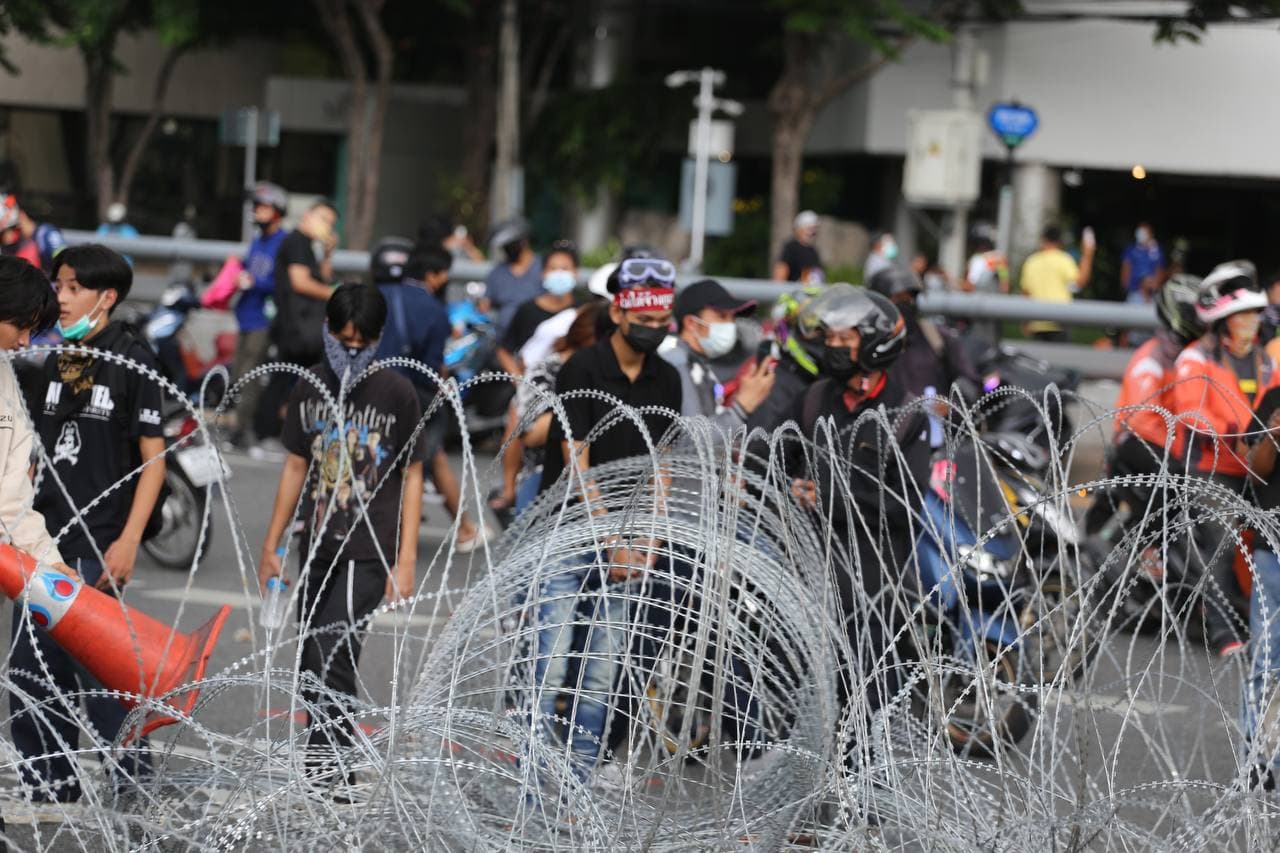
Public assembly on 11 August 2021 at the Victory Monument, Bangkok. Photo by Mob Data Thailand

Public assembly on 13 August 2021 from the Victory Monument to 1st Infantry Regement King's Own Bodyguard, Bangkok. Photo by Mob Data Thailand
Has there been a search or seizure of equipment from any particular groups of participants in a public assembly?
Even though according to the Penal Code, officials are vested with power to order a stop for search including body search and vehicle search, but such acts can only be imposed on participants or potential participants in a public assembly only when there is reasonable ground to believe that a serious crime is going to be committed or threatened to be committed. And this has to be done without discrimination. Nevertheless, at least nine members of We Volunteer were subject to vehicle search, and a search of their house and private residence prior to the beginning of the public assembly on 7 August 2021. It has led to them being pressed with charges concerning being members of secret society or criminal association, an offence against the Penal Code’s Sections 209 and 210 based on the articles found during the search and the allegation by the officials that they are going to be used to commit a crime even though it could not be verified if the persons arrested and charged had anything to do with the organization of the public assembly or not. In addition, members of the public who travelled between Samliam Din Daeng Intersection and Victory Monument were asked to stop for vehicle search, regardless if they were involved or were about to participate in the public assembly.
The use of arms and equipment by the officials during the public assembly dispersal and suppression including water cannon, tear gas, rubber bullets
The Guidance on Less-Lethal Weapons in Law Enforcement, 2020, of the ICCPR and other international standards adopted by UN Human Rights Institutions, it can be summarized that;
Water cannon
Water cannon should only be used in situations of serious public disorder “where there is a significant likelihood of loss of life, serious injury or the widespread destruction of property”. In order to meet the requirements of necessity and proportionality, the deployment of water cannon should be carefully planned and should be managed with rigorous command and control at a senior level.
Tear gas
Tear gas can be launched from a distance at groups of individuals engaged in violent acts. The aim of using chemical irritants dispersed at a distance is usually to cause the members of the group to disperse and to refrain from violence. In such circumstances, they should be fired at a high angle. Tear gas should not be aimed at a person and whatever circumstance, it shall not fired at the face since it may cause fatal risk to life and body.
Rubber bullets
The equipment can be used in response to the acts of throwing or hurling of objects including the use of rubber bullets, plastic bullets, impact rounds, baton rounds or bean bags which can only be used against "persons who commit violence." It should be fired with the aim of striking the lower abdomen or legs of a violent individual and only with a view to addressing “an imminent threat of injury to either a law enforcement official or a member of the public." Targeting the face or head may result in skull fracture and brain injury, damage to the eyes, including permanent blindness, or even death. Kinetic impact projectiles should not be fired in automatic mode. Multiple projectiles fired at the same time are inaccurate and, in general, their use cannot comply with the principles of necessity and proportionality.
The interval between the officials’ announcement and public assembly dispersal, the order of the weapons and equipment for public assembly dispersal, how the weapons and equipment are used against the protests, the distance, the trajectory and the targets, the number of injuries and description (if any)
Even though international human rights principles do not state clearly the interval between the announcement to disband a public assembly and the public assembly dispersal, but according to General Comment no. 37 concerning the use of less-lethal weapons. The equipment (tear gas, hydrant including water cannon truck, firearms including those used to fire rubber bullets) should be used only as a measure of last resort, ‘following a verbal warning, and with adequate opportunity given for assembly participants to disperse’. And in principle, a public assembly dispersal or the use of force to disband a public assembly should be done in compliance with the requirements of lawfulness, necessity, proportionality, reservation, and non-discrimination. In other word, the officials are prohibited from using force to arbitrarily disperse a public assembly. Therefore, such safeguard is provided in Section 21 of the Public Assembly Act 2015 which allows the police or other policing officials to use their discretion subject to the review of the court.
Nevertheless, since the imposition of the Emergency Decree on Public Administration in the State of Emergency 2005 for over one year and five months, the Public Assembly Act has been suspended and all of its requirements are temporarily not applicable to the officials policing a public assembly. As a result, in all cases, the officials simply invoked regulations pursuant to the Emergency Decree instead and made the claim that the participants have violated the aforementioned law. After that they shall deploy forces instantly in order to reclaim the area. In some cases, they may declare an off-limits zone or form a line to block the path of the demonstrators following with the use of crowd control weapons such as tear gas and rubber bullets and fire at the participants continuously.
They even aimed the firearms at the press who made the reporting at the incidence or claimed the acts of the participants were the contravention of the law labelling them as “burning down the city” or causing damage to public property. Otherwise, they would fire tear gas at a lower angle aiming to inflict injury on the participants such as the firing from the express way close to the Samliam Din Daeng Intersection. Some tear gas canisters have thus fallen into private residences of local people. In addition, some crowd control officials just patrol around to identify and arrest the participants and fired rubber bullets into private residences of people who lived near Din Daeng. Or during the public assembly dispersal on 11 August 2021, it has been reported that firecrackers and paint were hurled at the officials who formed a line of defense to block access of the participants on Phahonyothin Rd. around the Victory Monument. This has prompted the officials to fire rubber bullets to clear the way and conduct an arrest of the participants instantly. In another case, while the participants were trying to remove some ship containers, and some were hurling firebombs over the containers, the officials have responded by firing rubber bullets and tear gas to immediately disperse the crowd. Even after calm has been restored, the officials continued to use such weapons incessantly causing serious injuries including at least two individuals who were made blind from the incidence.
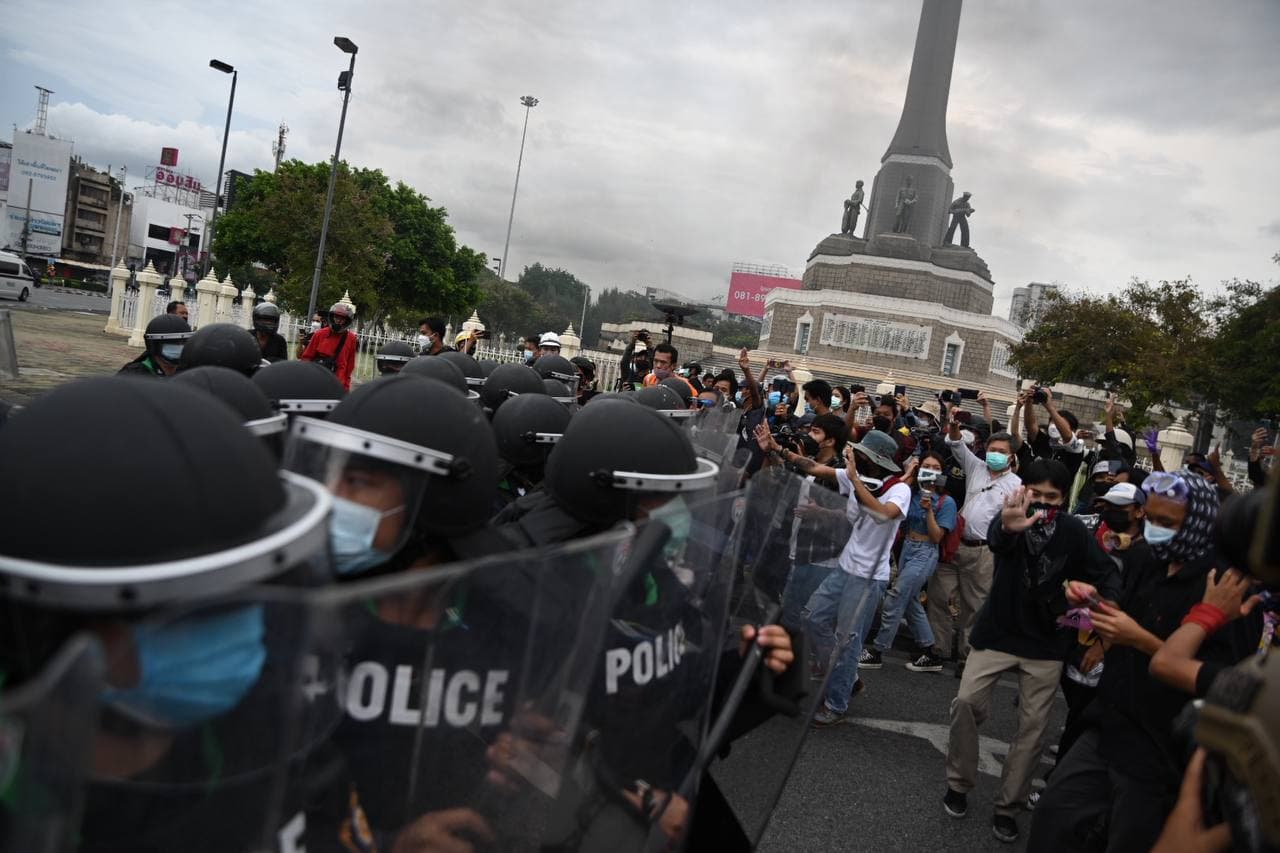
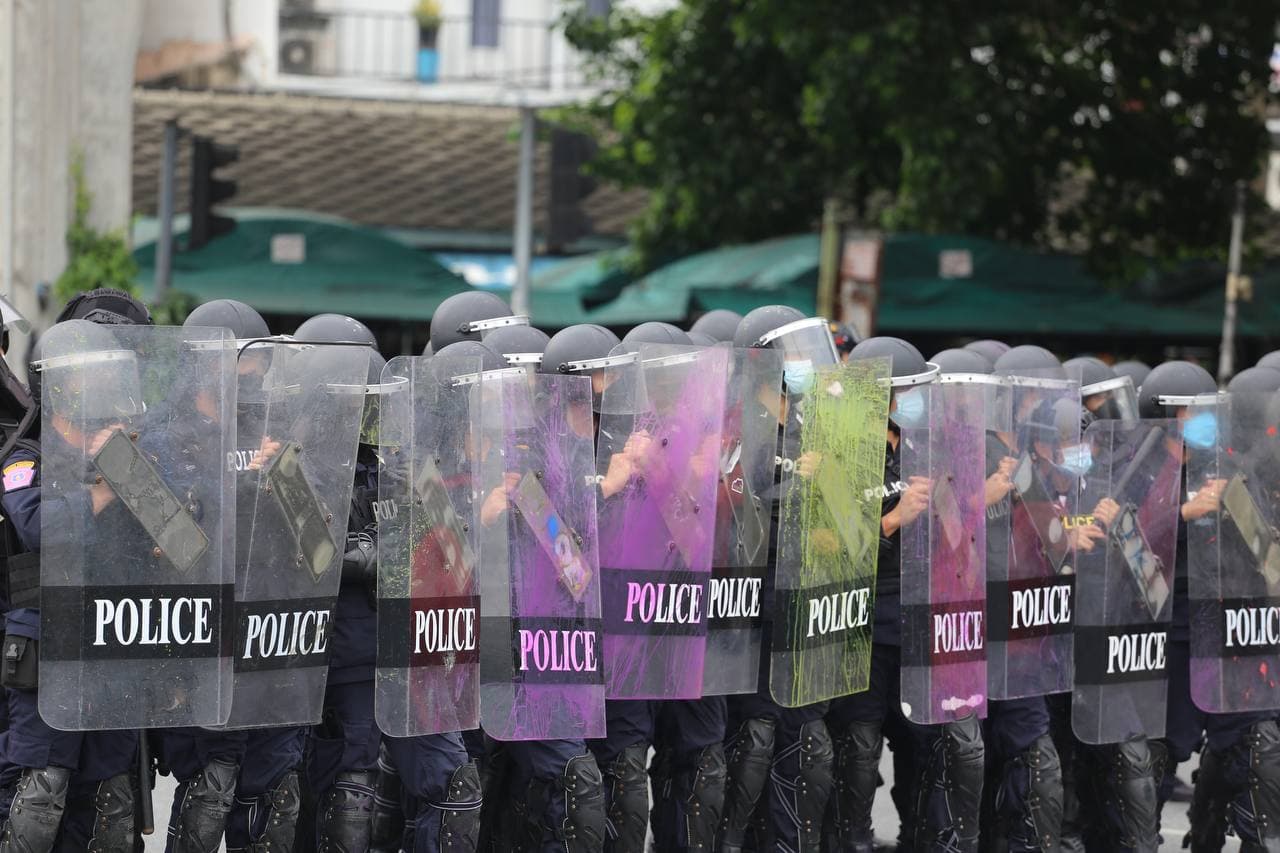
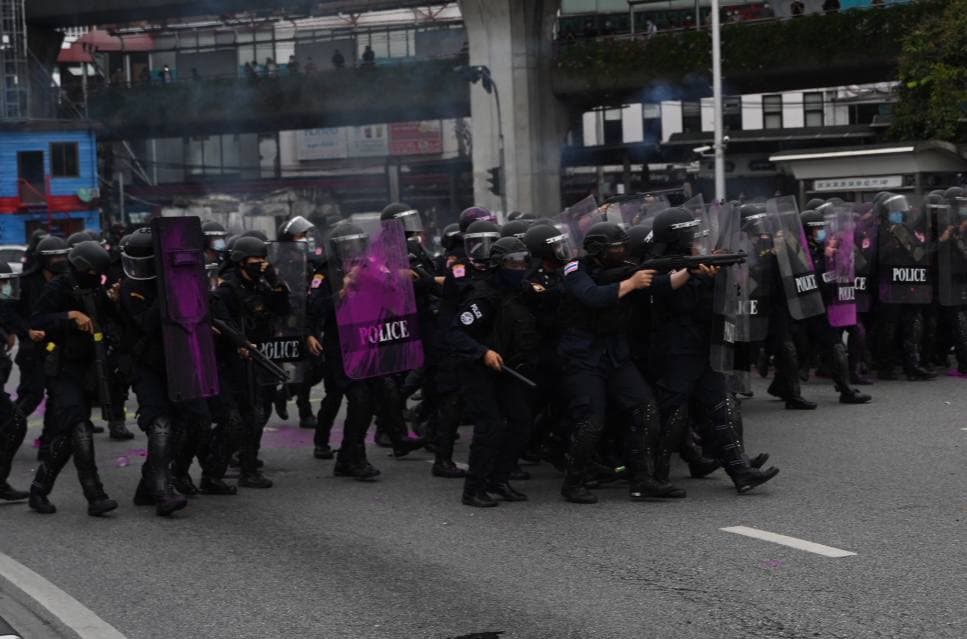
The dispersal of the public assembly on 11 August 2021 at the Victory Monument, Bangkok. Photo by Mob Data Thailand.
The use and firing of tear gas in the five cases against public assemblies therefore did not take place from a distance against violent individuals. Rather, they were fired at a short distance, despite the claim that it was made in response to the use of violence. The acts of the officials have, however, caused excessive damage to life and body of the targeted persons. Moreover, by firing tear gas and rubber bullets indiscriminately with aim of lower part of the body, the officials should clearly have realized the magnitude of damage on the life and body of other protesters who were not violent individuals. A case in point is Mr. Thanat Thanakit Amnuay and another independent monitor who got injured from tear gas canisters and the former has lost one of his eyes. The act was also a breach of the prohibition against firing tear gas at the head or face of a person. In addition, the officials have adopted the kettling or containment tactic against demonstrators at the Samliam Din Daeng Intersection and fired a barrage of tear gas and rubber bullets, which contravenes the basic requirements on the necessity and proportionality for the use of such weapons and the General Comment that prohibits firing tear gas in confined spaces.
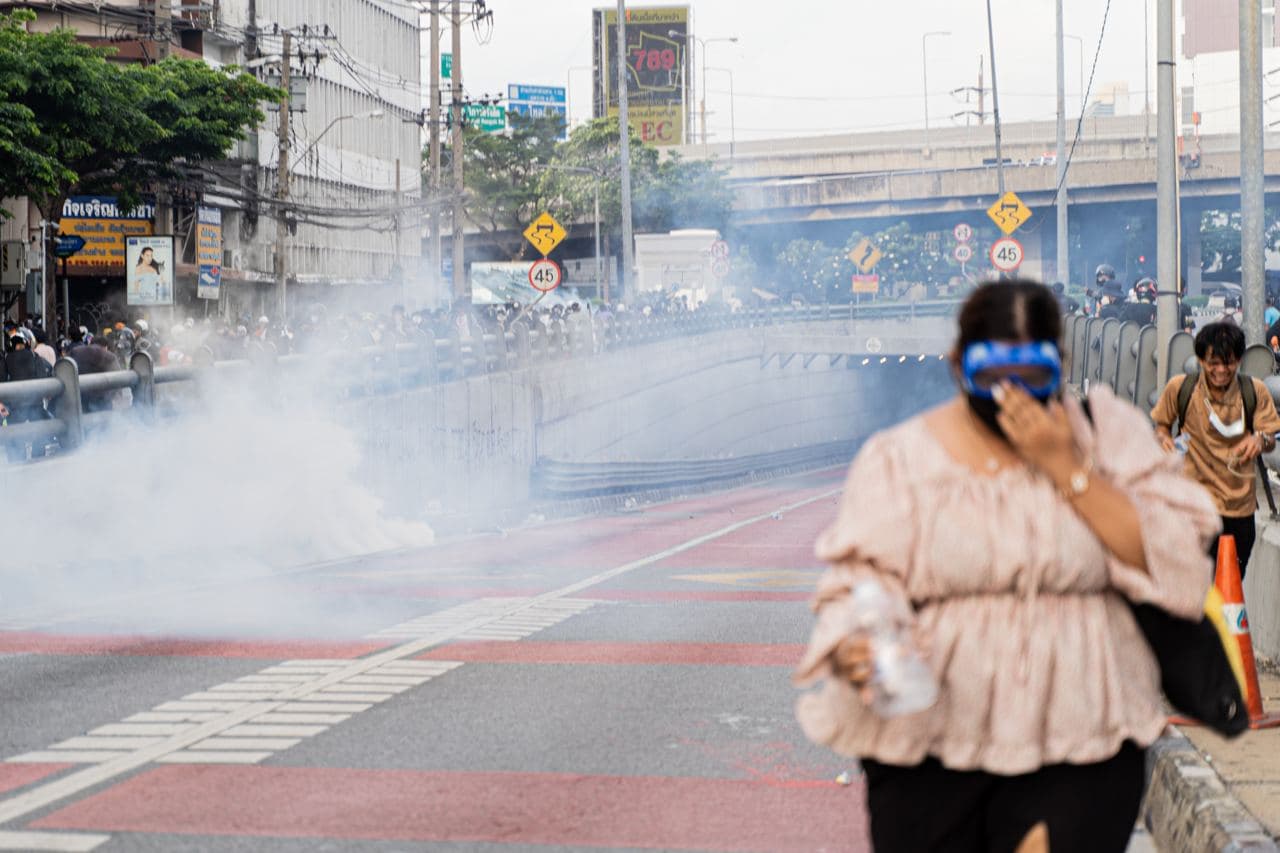

The dispersal of the public assembly on 10 August 2021 from Ratchaprasong Intersection to King Power Rang Nam. Photo by Mob Data Thailand.
As to the use of rubber bullets, similarly, it should aim at stopping the violent persons and to isolate the persons from the other protesters. Nevertheless, by firing rubber bullets indiscriminately or by firing just to pave the way for crowd control officials to arrest some protesters, or by firing from moving vehicles to intentionally cause the protesters to fall down or to stop their driving, they are the use of rubber bullets which does not comply with the requirement that it can be used only when there is an imminent threat against either the officials or members of the public. Moreover, the firing of rubber bullets into private residence believing that it was a place where protesters were hiding out is also definitely the unlawful use of rubber bullets.
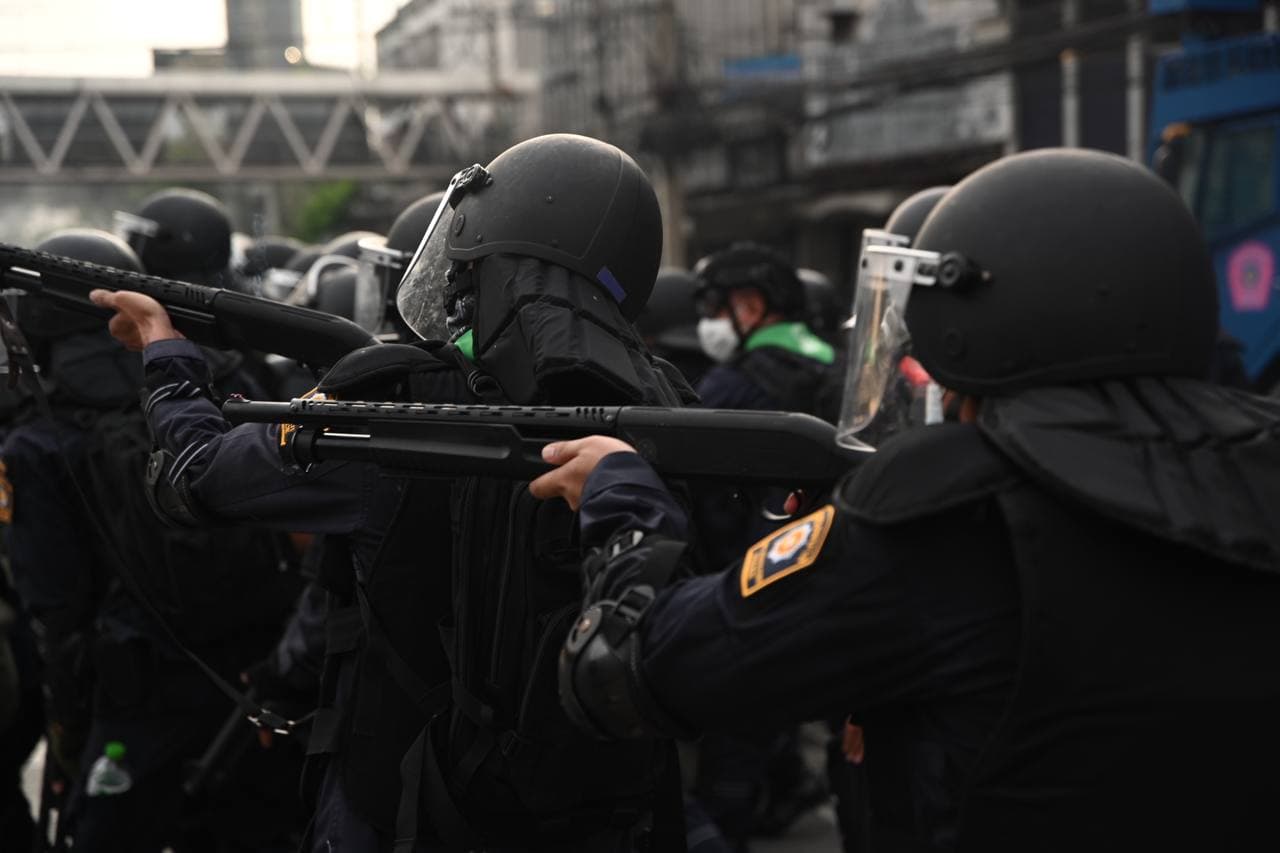
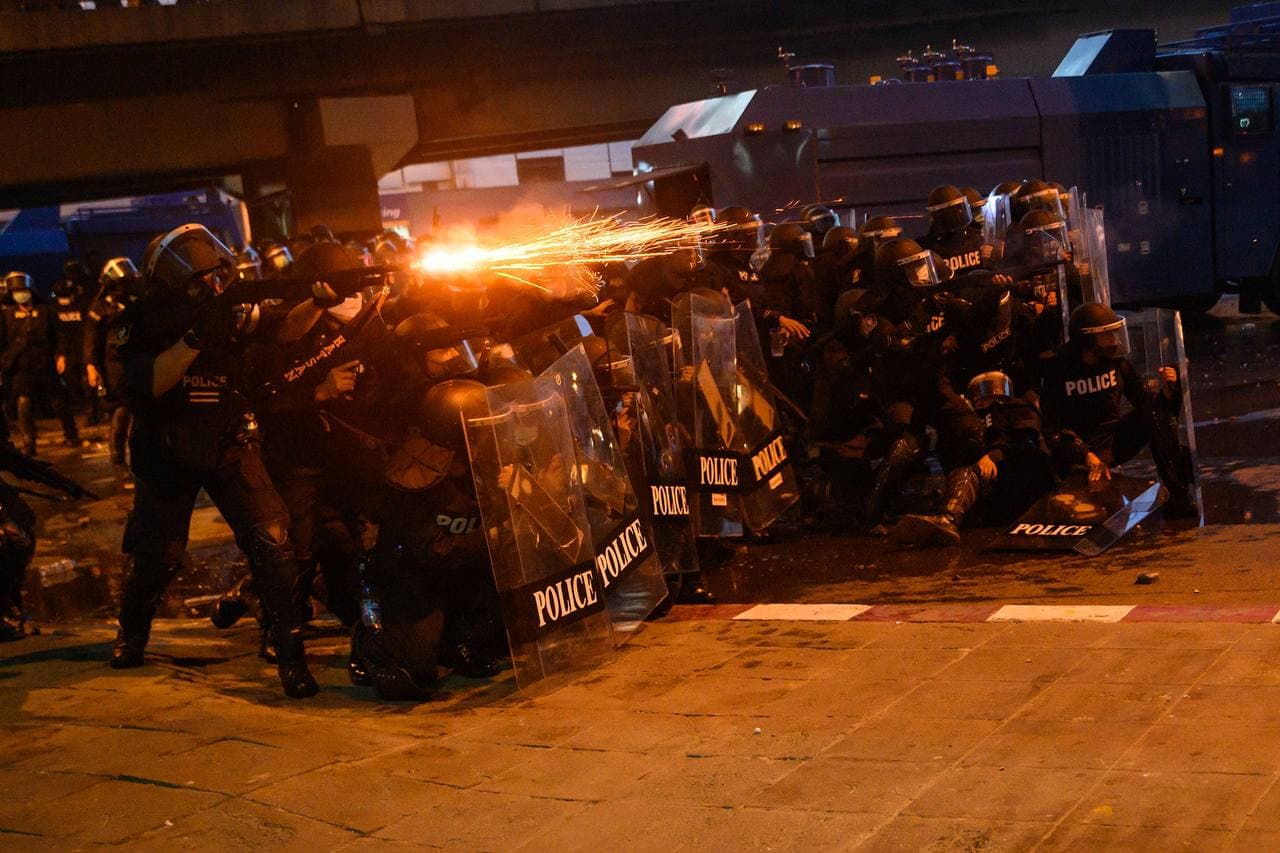
The dispersal of the public assembly on 10 August 2021 from Ratchaprasong Intersection to King Power Rang Nam. Photo by Mob Data Thailand.
In addition, the UN Human Rights Committee has emphasized that such firearms are not an appropriate tool for the policing of assemblies. and they must never be used simply to disperse an assembly. The facts about the use of such rubber bullets aforementioned do not constitute an exception specified in General Comment no. 37 which states that rubber bullets ‘must be limited to targeted individuals in circumstances in which it is strictly necessary to confront an imminent threat of death or serious injury’.’ Meanwhile, big firecrackers, paints and objects are not included in the definition and expectation concerning an imminent threat of death or serious injury. As to the explanation from the officials that they have found some individuals using live bullets or carrying firearms into the protesting area, Amnesty International Thailand is not aware of the guidelines in response to such person or groups of persons. After all, the explanation has only been given after the officials have already fired tear gas into the area where there were other protesters as well.
As to the water cannon truck, it should be used only as the last resort by the officials. Nevertheless, water cannon has been used for public assembly dispersal since late 2020 and it was the first time the officials attempted to disperse the crowd in a confined space and in the middle of community. It has unleashed indiscriminate impact on nearby people including monitors as well. In addition, it has been reported that the officials fired water cannon at the protesters to pave the way for the containment or the reclamation of the space from the protesters even though the situation did not appear to pose an imminent threat of death or serious injury, albeit it could be aimed at preventing the damage of property (i.e. breaking mirror or setting fire on traffic police boxes at the Samliam Din Daeng Intersection). Some could still argue that after the fire was put out, they could have stopped using water cannon immediately. Therefore, the continuous use of water cannon to clear the way is a breach to the requirements of necessity and proportionality of the use of such weapon.
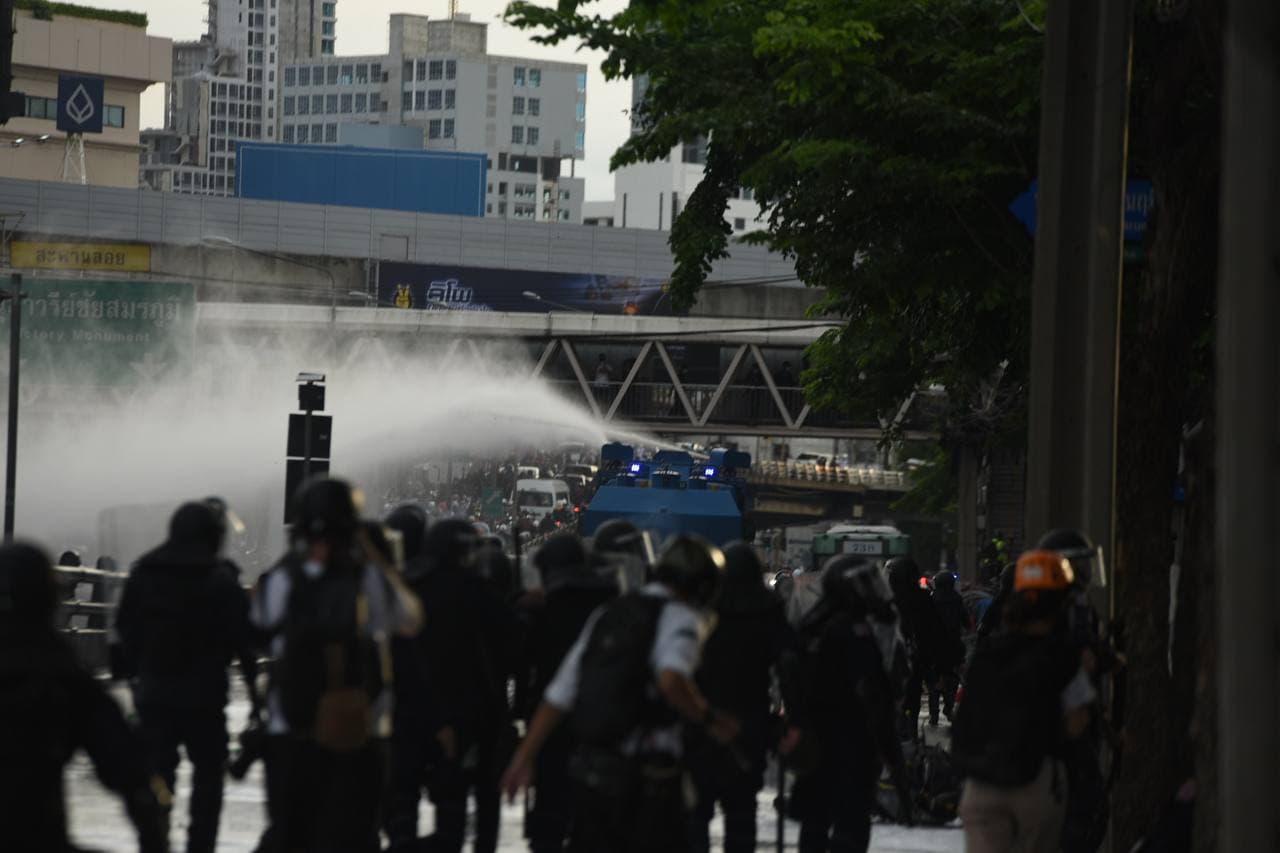
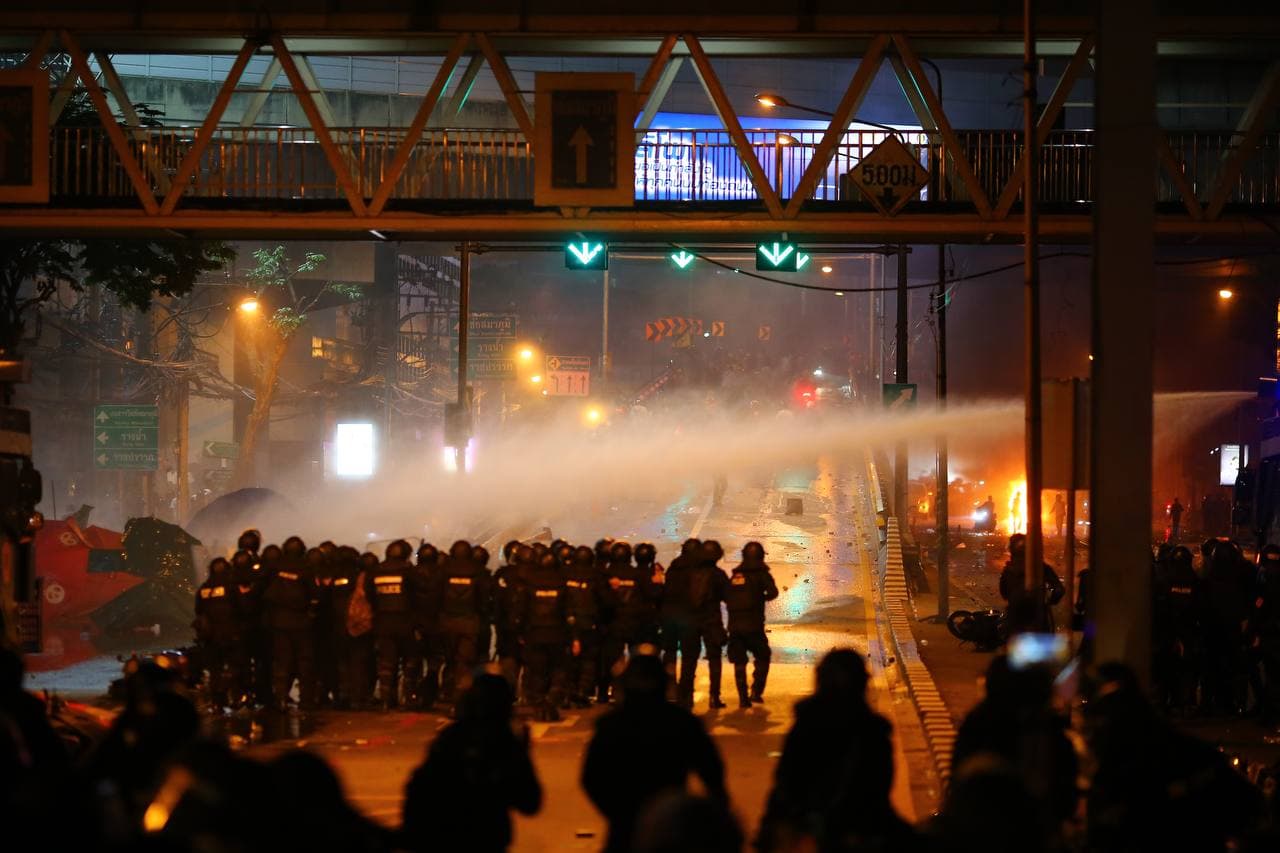
The dispersal of the public assembly on 10 August 2021 from Ratchaprasong Intersection to King Power Rang Nam. Photo by Mob Data Thailand.
Have other weapons been used such as firearms and live bullets?
There have been reports only from the Royal Thai Police’s spokespersons that a group of five or six individuals were found to have carried with them real firearms to the protest sites, although there has been no report or investigation to verify the claim by the officials.
Has there been the use of violence by the protesters or not? If so, please indicate which weapons or equipment have been used to perpetuate violence. Have the officials made an attempt to isolate the violent persons or to use such equipment specifically targeting the violent persons or not?
As a principle, international and domestic legal frameworks tend to protect only a peaceful public assembly. The question of whether or not an assembly is peaceful must be answered ‘with reference to violence that originates from the participants. Violence against participants in a peaceful assembly by the authorities, or by agents provocateurs acting on their behalf, does not render the assembly non-peaceful’.
AIT has found that according to our documentation during 7-15 August 2021, the violence that originated from the participants, be it, an attempt to penetrate the cordon of crowd control officials, the removal or relocation of ship containers, the hurling of objects, the hurling of big firecrackers and the lighting of fireworks, was committed continuously in response to the containment and blockade of their procession through roads or to the areas where they intended to converge. Moreover, isolated acts of violence by some participants should not be attributed to others and solutions should be made meeting the requirements of necessity and proportionality. Such violence should not be attributed to other participants including the organizers or to the assembly as a whole. The participants still warrant protection pursuant to Article 21 of the ICCPR. Nevertheless, according to our initial documentation, the authorities have yet to make an attempt to identify the persons who cause harm to life, body and public property. The use of less-lethal weapons including water cannon, tear gas and the firing of rubber bullets as well as the use of force to carry out the arrest, even though they are included among measures which can be used for public assembly dispersal, but if the officials fail to strictly adhere to the requirements, it may cause widespread consequences and damage. Therefore, the officials must always abide by the requirements of proportionality and reasonability.
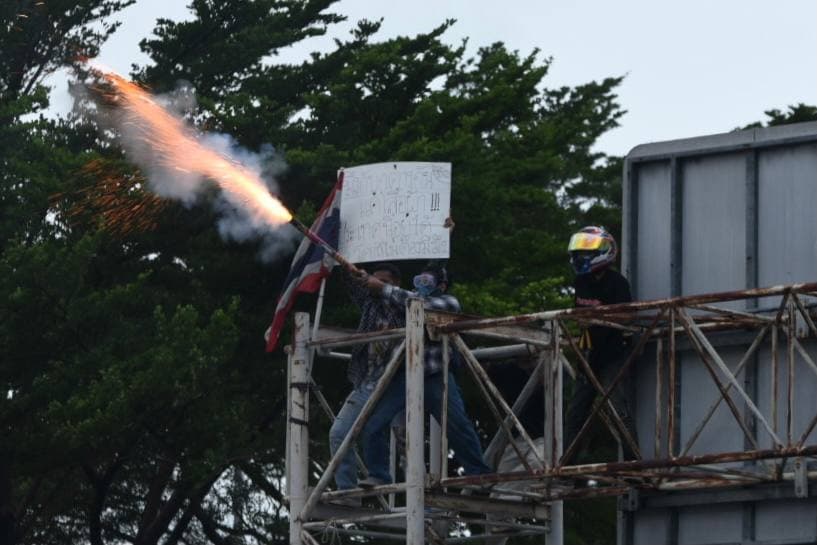
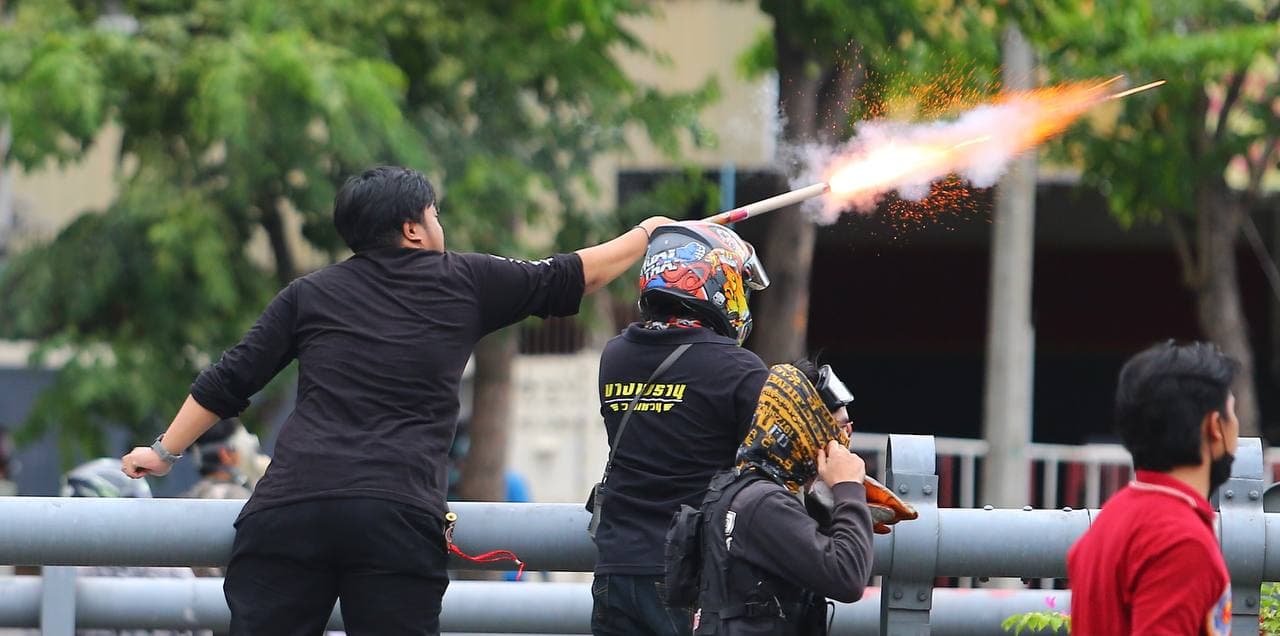

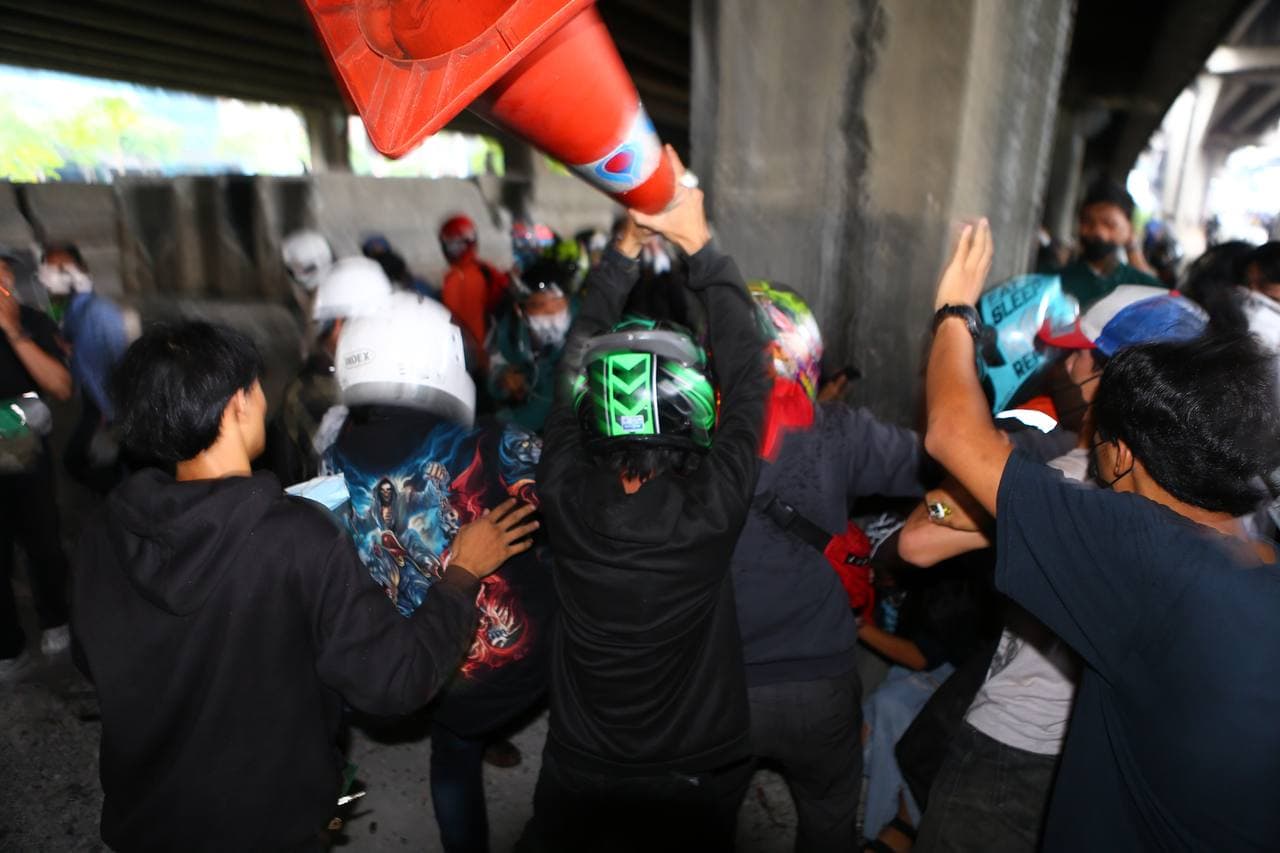
Protesters' use of violence during the 15 August 2021 public assembly at Ratchaprasong Intersection, Bangkok. Photo by Mob Data Thailand.
How the officials respond to children and youth present in the protest
Has there been an attempt to isolate or take care of children and youth in the protest site? If not, please explain how the officials treat children and youth present in the protest
As a general rule for the execution of duties and the exercise of force by officials to facilitate the activities by the participants should only be made by the officials who have received training on crowd control. Such training should sensitize officials to the specific needs of individuals or groups in situations of vulnerability, which may in some cases include women, children and persons with disabilities, when participating in peaceful assemblies.
Nevertheless, AIT has found no special measures have been adopted to facilitate and protect children and youth participating in a peaceful public assembly. On the contrary, children and youth have often been viewed as people who have caused turbulence, particularly at the Samliam Din Daeng Intersection. From 7 August 2021 until now. a number of children and youth have been arrested from participating in the public assemblies in the area. Some of them were not participants of the public assemblies and were just passersby. It indicates that in practicality and in principle, the authorities have adopted no special measures to help the children and youth to exercise their right to freedom of peaceful assembly even though the right to freedom of public assembly and expression is a guaranteed right for children and youth. It is a right that has to be protected, upheld, and promoted according to the International Covenant on Civil and Political Rights (ICCPR) and the UN Convention on the Rights of the Child.
If children or youth were held in custody, please indicate the measures adopted by the officials when carrying out the arrests. Have there been children or youth who got injured during the arrest? Explain in brief the charges against them, the detention facilities, other rights of the child including the right to meet with their parents, the right to medical treatment and the right to meet with their legal counsel
As mentioned above, during 7-15 August 2021, a large number of children and youth were arrested. According to TLHR, Child in Mob and Mob Data Thailand, there were three children and youth who were not arrested instantly but were later summoned to answer to charges against them, particularly for organizing Car Mob activities. One minor has turned himself in on 10 August 2021. The children and youth were arrested mostly for participating in the public assemblies at the Samliam Din Daeng Intersection and Amnesty International Thailand has found most of them have been arrested without warrants (the police claimed they have committed a flagrant offence). During the arrest, the officials used force and some of them had their hands cuffed or wrapped with cable tires. In addition, even though they may have been injured during the arrests, they may not be sent to receive treatment right away. Rather, they would be brought to the Narcotics Suppression Bureau. In most cases, the children and youth would have their mobile phones seized, and some even have their motorcycles seized as well. The attorneys were allowed to meet with the arrestees including youth, only after their arrest reports have been completed. It turned out later that in some cases, it mentions in the arrest reports that the children and youth have pleaded guilty to the charges. This happened since many arrests took place at nighttime and the children and youth were unable to meet their parents in time. Meanwhile, the attorneys were not allowed to meet with the children before arrest reports have been prepared. After that, the police would have them answer to the changes during the nights and brought them for an arraignment at the Central Juvenile and Family Court the following morning.
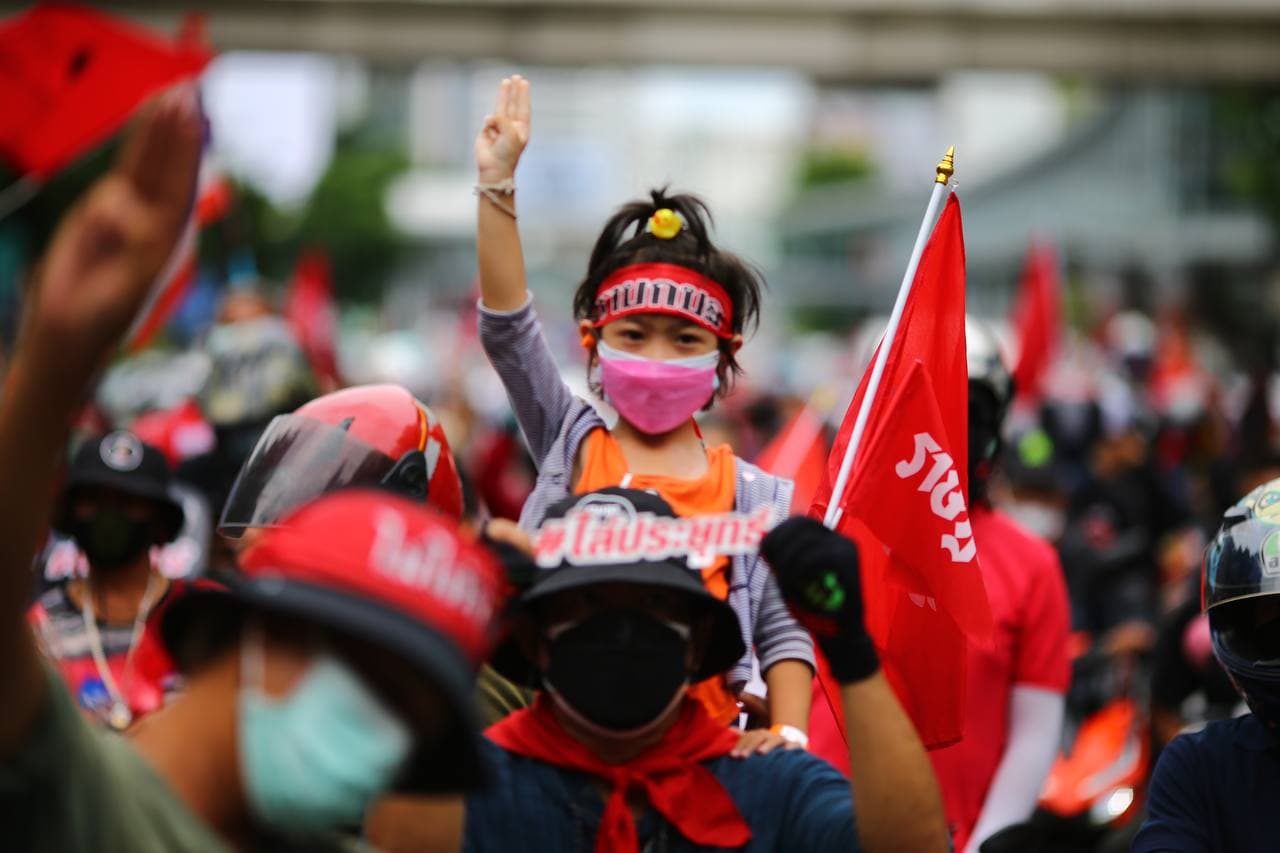
Public assembly on 15 August 2021 at Ratchaprasong Intersection, Bangkok. Photo by Mob Data Thailand.
Detail of the arrests, detentions and the right to medical treatment and timely access to attorneys can be described as follows;
On 10 August 2021, 12 children and youth were arrested, the youngest of whom was about 13. They could be divided into two groups. The first group were arrested at the Samliam Din Daeng Intersection, after the vandalization of traffic control box at the Victory Monument. The crowd control officials gave chase to the participants including those non-participants but being present there. It has led to injuries among at least three arrested children and youth from the use of force by the officials. One was shot with rubber bullet at the upper part of his right arm, and the other boy just under his elbow. Another boy was fired at with tear gas in close range during the public assembly dispersal. Another child said he was beaten up by a group of officials and hit in his head and back by hard objects. In addition, the arrested children and youth were restrained to prevent their escape. And the injured persons were not brought to receive treatment timely. They were taken to the Din Daeng Police Station instead. The other two children and youth were arrested from the entrance of the Provost Marshal General Department being stopped at the checkpoint by the military officials. They were later brought to the police and was searched and held in custody at the Phayathai Police Station.
On 11 August 2021, two children and youth were arrested. One of them was arrested from the Victory Monument and was one of the 13 arrestees. There was no information if the youth was subject to physical assault during the arrest or not. For the rest of the arrestees, some were kicked and fell from their motorcycles and was then arrested. Some were charged in by the crowd control officials during the arrest causing them to feel pain in their arms and bodies. Another 15-year-old-boy was arrested from the entrance of the Royal Thai Army Medical Department by the crowd control officials. He was shot with rubber bullets on his left arm, although there was no clear information to verify if he has participated in the public assembly. The officials charged the youth with violating the Emergency Decree on Public Administration in the State of Emergency by breaching the curfew ban from 21.00-04.00. Both persons and other arrestees were held in custody at the Narcotics Suppression Bureau.
On 15 August 2021, two children and youth were arrested. One of them was a restaurant staff and was on his way home. He was stopped and had his body and vehicle searched. After it got past the curfew time, he was then pressed with charges concerning the violation of the Emergency Decree on Public Administration in the State of Emergency and was held in custody at the Narcotics Suppression Bureau the whole night. Another youth sustained serious injury as he was shot at with as many as six rubber bullets. According to him, he was shot at while riding a motorcycle to get away from the protest site and the officials were cordoning off the area and carrying out the public assembly dispersal. At the Our Lady of Fátima Catholic Church, he confronted the crowd control officials who rode in the back of three or four pickup trucks. On each truck, they fired the rubber bullets at him in close range, particularly at his head. None of the officials took aim at the lower part of his body. It made him feel dizzy and fatigue. After the arrest, he was taken into custody at the Narcotics Suppression Bureau. Even though he suffered quite serious condition, but the officials did not allow him to receive treatment at the hospital. He also had to wait several hours before he got to meet with his attorneys who told the police to send him to hospital for treatment before having him answer to the charges. The youth also mentioned that while being driven to his custody, the officials accompanying him kept threatening him saying that if he “makes any trick, he would be shot dead”.
Treatment of the Juvenile and Family Court (if any), i.e., the amount required to post bail, etc.
According to safeguards in the criminal justice process to protect the rights of persons in custody, it requires that the person under arrest be brought to the court at the first possible opportunity. The Juvenile and Family Court and Juvenile and Family Case Procedure Act 2010 requires such children or youth under arrest be brought for a review at the court within 24 hours after the arrest. Nevertheless, such requirement does not lead to the protection of the child arrestees since the court only starts counting from the time when the children and youth met with the inquiry officials. They do not count the time when the children or youth were arrested by the crowd control officials from the protest sites even though during that time at least five children and youth were subject to physical assault or sustained injury from rubber bullets and tear gas. The court has so far ruled the arrests in such circumstances have been carried out lawfully according to Section 72 of the Juvenile and Family Court and Juvenile and Family Case Procedure Act.
In general, individuals alleged to have violated the Emergency Decree on Public Administration in the State of Emergency have often been granted bail by own recognizance. But in the case of a youth who turned himself in at the Pathumwan Police Station on 10 August 2021, he was required to post bail for 30,000 baht.42 In addition, the inquiry officials should use their discretion to grant bail pending the investigation. But, in reality, the inquiry officials have never used their discretionary power even though it could be verified later on that some youth had never participated in the public assemblies, but they were arrested. The inquiry officials would bring all of them to the Juvenile and Family Court to request for remand in custody in all cases.
Treatment of authorities toward the press and monitors during public assemblies
Policies-statements by the Royal Thai Police and the Metropolitan Police Bureau (if any) concerning the press’s activity
Media and monitors in public assemblies warrant protection and play an important role to support the exercise of the right to freedom of peaceful assembly. Media and monitors in public assemblies should therefore be protection by the state according to their obligations toward international treaties and according to the interpretation of the UN Human Rights Committee in its General Comment no. 37. They may not be prohibited from, or unduly limited in, exercising these functions, including with respect to monitoring the actions of law enforcement officials. They must not face reprisals or other harassment, and their equipment must not be confiscated or damaged. Even if an assembly is declared unlawful or is dispersed, that does not terminate the right to monitor. Nevertheless, according to the press conference at the Metropolitan Police Bureau under the Royal Thai Police on 10 August 2021, Pol Maj Gen Yingyot Thepjamnong reminded media of their stand and advised media who operated in the protest sites for their safety. He claimed some media people have failed to act as advised by the officials.
Measures or treatment of the officials toward media or monitors of public assemblies
Have media/monitors of public assemblies been prevented from entering the protest sites? How similar and how different the officials treated media who wore and did not wear press armbands?
Have weapons or other equipment such as rubber bullets, tear gas, water cannon and others been used to target media or monitors or not?
Indicate the number of persons who sustained injuries or have their equipment used for reporting damaged.
Amnesty International Thailand notes that during the public assemblies from 7-15 August 2021, the crowd control officials did not differentiate media or monitors from the participants. For example, during the public assembly on 7 August 2021, media tried to isolate themselves from the participants and stood on the sidewalks to do their reporting at the Samliam Din Daeng Intersection. Nevertheless, the crowd control officials just fired tear gas and rubber bullets at the media. Or on 13 August 2021, tear gas and rubber bullets were fired at the media and monitors as well as some other participants who took refuge at the ground floor of Thaivivat Insurance building, Din Daeng close to the intersection with the outbound Vibhavadi Rangsit Rd. As a result, the area was filled with tear gas. In addition, it has been reported that Voice TV’s reporter and another female photographer of a news outlet were shot with rubber bullets and sustained slight injuries while hunkering down in the parking building. The officials even fired rubber bullets to the fifth floor of Thaivivat Insurance building where people were hiding inside. Even if some reporters raised their armbands to prove they were media, the firing did not stop. What the officials have done showed how the crowd control officials did not differentiate between the media notwithstanding if they wore armbands and who did not and the monitors from the participants. The officials treated them all the same and failed to protect their freedoms which should be upheld by Articles 21 and 19 including freedom of expression and freedom of information.

